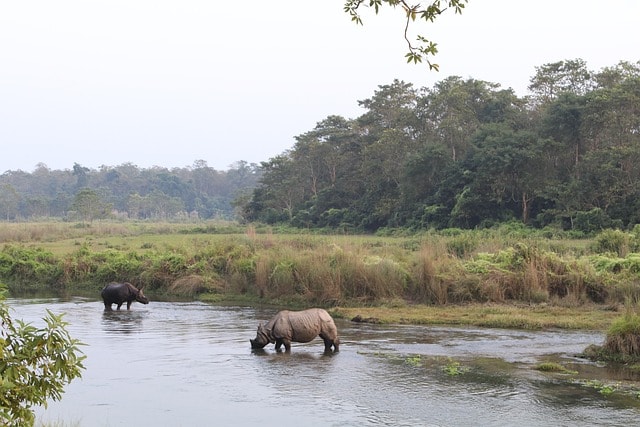Chitwan – Where the Wild Roam Freely

A Quick Glimpse into Chitwan’s History
Chitwan, which means “Heart of the Jungle,” was once an isolated forest home to tigers, rhinos, and malaria. Until the 1950s, very few outsiders dared enter this steamy lowland region. With the eradication of malaria and the declaration of Chitwan National Park in 1973 (Nepal’s first national park), the region bloomed into a haven for conservation and eco-tourism.
Today, Chitwan thrives as both a cultural heartland and a wildlife destination, loved by budget travelers and nature enthusiasts alike.
Fun Facts About Chitwan
-
Chitwan is one of the best places in Asia to see wild one-horned rhinos.
-
If you're lucky, you might spot a Bengal tiger during a jungle safari.
-
It is home to the Tharu people, one of Nepal’s most fascinating indigenous communities.
-
The Rapti River is famous for canoe rides alongside crocodiles and exotic birds.
Must-Visit Places in and Around Chitwan
1. Chitwan National Park
A UNESCO World Heritage Site, the park is home to over 700 wildlife species. Go for:
-
Jeep safaris
-
Jungle walks
-
Elephant viewing (choose ethical experiences only!)
2. Sauraha
The main tourist hub near the park — is full of chill hostels, riverfront cafés, bicycle rentals, and travel agencies. Great for meeting other travelers.
3. Elephant Breeding Center
A short ride from Sauraha, this is where you can learn about elephant conservation. It’s low-key, informative, and heartwarming.
4. Tharu Cultural Museum & Stick Dance Shows
Immerse yourself in local life through Tharu dance, traditional homes, and their resilient history of living in the jungle.
5. Bishazari Tal (20,000 Lakes)
A lesser-known wetland sanctuary—perfect for bird watching and cycling. Very peaceful, especially during sunrise.
Hidden Gems You’ll Love
1. Devghat
A sacred site where the Kali Gandaki and Trishuli rivers meet. Think peaceful ashrams, river bathing, and mystical temples — away from the crowd.
2. Meghauli Village
An alternative to Sauraha with fewer tourists and more authentic homestays. Great for spotting wildlife in the buffer zone.
3. Jungle Tower Stay
Spend a night inside the jungle in a raised tower listening to animals under the stars. A raw, thrilling experience.
4. River Sunset Point in Sauraha
Where backpackers gather each evening. Grab a beer, sit on the riverbank, and watch elephants bathe as the sun goes down.
Travel Guide for Backpackers
Where to Stay (Budget Hostel Picks)
-
Hotel Rhino Land – Affordable, cozy, and 2 minutes from the river.
-
Jungle Wildlife Camp – Basic but clean rooms with great local hosts.
-
Backpacker’s Jungle Camp – Dorms, hammocks, bonfires… the vibe is real.
What to Eat
-
Tharu-style fish curry
-
Dhido with Gundruk soup
-
Locally brewed rice beer ("Raksi")
-
Cafés like Friends Café, KC’s Restaurant, and Sunset View are backpacker favorites.
How to Reach Chitwan
-
From Kathmandu or Pokhara: Tourist buses (5–7 hrs), private vans, or domestic flights to Bharatpur Airport.
-
Local Tip: Book a morning bus to avoid midday heat and traffic.
Best Time to Visit
-
October to March: Cooler, great for safaris.
-
April to June: Hot but fewer tourists.
-
Monsoon (July–Sept): Lush and beautiful, but muddy roads and limited activities.
Top Things to Do in Chitwan for Hostel Travellers
-
Jungle Walk with local guides (always go in a group)
-
Canoe ride with crocodile sightings
-
Fishing with locals at the river
-
Rent a cycle and explore Tharu villages
-
Bonfire nights & travel stories with fellow backpackers
Respect Wildlife and Travel Sustainably
Chitwan offers wild beauty, but it comes with responsibility. Always:
-
Avoid elephant-back rides — opt for walking or jeep safaris.
-
Don’t feed animals or litter in the jungle.
-
Support local eco-lodges and handmade crafts.
Why Backpackers Fall in Love with Chitwan
Because it’s wild without the chaos, cultural without the crowd, and cheap without the compromise. Chitwan is where you trade WiFi for wildlife, and noisy cities for jungle silence. One day you’re floating past crocodiles, the next you're learning to cook Tharu food in a homestay.
It's not just a place — it's a feeling of raw, real Nepal.
